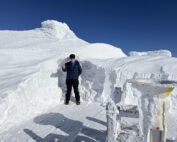High Pressure
2013-11-19 22:37:53.000 – Tom Padham, Weather Observer
NULL
Ever wonder why the “high pressure” meteorologists talk about is usually associated with nice weather? High atmospheric (or barometric) pressure causes sinking motions of air at the surface, meaning the air underneath a high pressure is both warming and drying out as it descends towards the surface. This tends to suppress cloud development, and often leads to clear or mostly clear skies underneath the high pressure like we have seen over the past few days. Winds underneath a high pressure system are generally light because there is typically little change in pressure around the high. Winds tend to spread out from the center of the high (moving towards lower pressure), and slowly rotate in a clockwise fashion. Because of this we typically see our coldest weather in the Northern Hemisphere when we are either directly under or on the east side of the system and have northerly winds (which we currently are).
The strongest high pressure systems are usually found during the winter season during extremely cold and dry conditions. Typically in North America a very strong high pressure ranges in the 1040 mb to 1050 mb range (standard sea level pressure is 1013.25 mb).The highest barometric pressure ever recorded occurred on December 13, 1968 at Agata Lake in Sibera. The pressure was an amazing 1083.8 mb, and the current temperature at the time was about -51 degrees Fahrenheit.
Tom Padham, Weather Observer
An Experience Worth 1,000 More
An Experience Worth 1,000 More By Mitchell Tsokatos Me and the summit sign once winter really got going. Taken 11/2/25. Unfortunately, my time on Mount Washington as an intern has come to
Supporter Spotlight: AJ Mastrangelo
Supporter Spotlight: AJ Mastrangelo By Wendy Almeida A young AJ on the summit with Rebecca Scholand. AJ Mastrangelo’s relationship with Mount Washington Observatory began long before his internship—or his current career as
Supporter Spotlight: Angelo Decrisantis
Supporter Spotlight: Angelo Decrisantis By Wendy Almeida For Angelo Decrisantis, Mount Washington has been a lifelong connection. It began in 1965, at age 15, on a family drive to the summit. “My first experience



